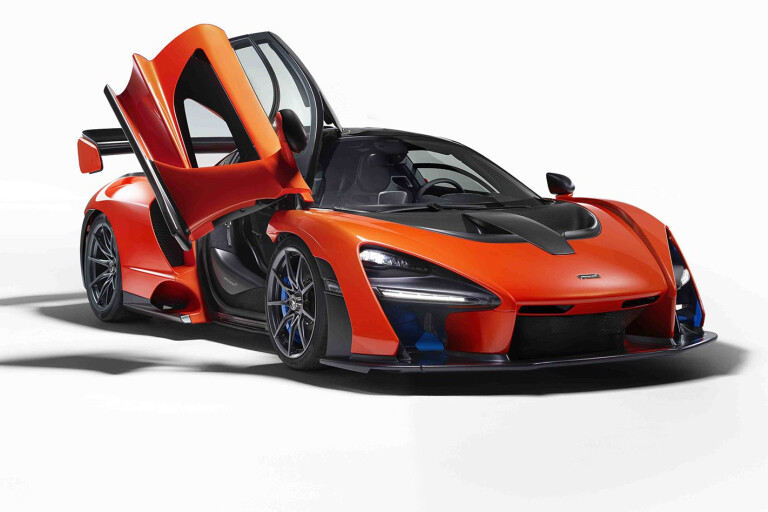
McLAREN’S answer to the Aston Martin Valkyrie and the Mercedes-AMG Project One now has a name: it will be called the Senna.
The hypercar’s name is a tribute to Formula 1 driver Ayrton Senna, the Brazilian driver who won three world championships behind the wheel of a McLaren.
It boasts some stupidly impressive numbers. First is the price: each one of the hand-assembled Sennas will cost ₤750,000, or the equivalent of more than $1.3 million Australian to add one to your garage.

Only 500 will be made, with production starting late next year. It will produce 588kW and 800Nm via a dry-sumped, flat plane crank “M840TR” 4.0-litre twin-turbo V8 – the most powerful engine the brand has ever created.
A lightweight carbonfibre construction means the Senna weighs just 1198 kilograms, almost the same as a Mazda MX-5, which gives it a power-to-weight ratio of 490kW/tonne, enough to conservatively give it a potential 0-100km/h in the mid-to-high 2.0 seconds range.
It’s made for carving corners. The McLaren Senna – formerly known as the P15, the name of the Super Series project that spawned it – includes what the car maker calls “RaceActive Chassis Control II”, a double-wishbone suspension system with interconnected hydraulic dampers that make anti-roll bars redundant. Of note, the dynamic dampers adapted from the McLaren P1 now include a race mode – along with comfort, sport and track – that allows the Senna to hunker down and hug the road surface, lowers the centre of gravity and makes the suspension “significantly stiffer”.
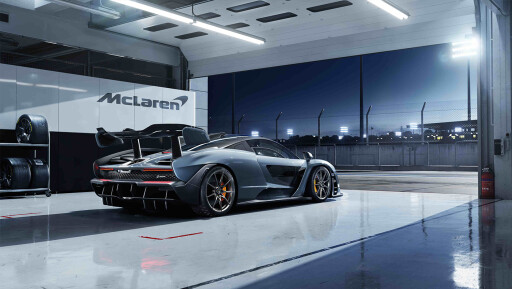
The McLaren Senna features a Formula 1-style teardrop body with other more roadgoing components “clipped” onto the cabin, McLaren says.
“McLaren’s designers went to extremes by cutting open the ‘shrink-wrapped’ body to reduce weight visually and functionally; while recognisably a McLaren in proportional terms, you cannot follow a single line from the front to the rear without it passing through a functional air intake or vent,” it said.
The carmaker said the Senna introduced “a new generation of ground-breaking front and rear active aerodynamics”.
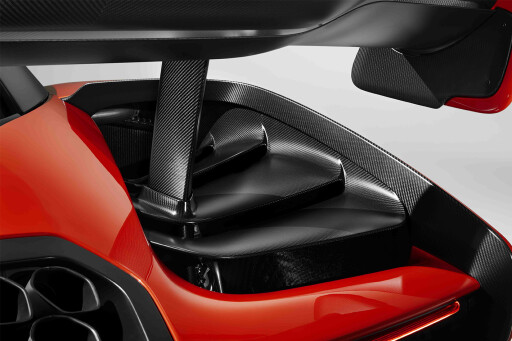
“Every element of the body design, from the front splitter to the double diffuser at the rear, has been developed to optimise downforce and aerodynamic balance, whether under braking, adjusting the throttle mid corner, or applying power on corner exit,” McLaren said.
“There is also an opportunity for added visual drama, with the front aero blades available finished in one of five ‘By McLaren’ theme specifications that include Azura Blue and McLaren Orange. The same linked accent colour can also feature on the brake calipers, visible door gas struts and seat trims.”
There’s a visual link to the original McLaren F1; the dihedral doors hinge forwards and upwards, opening with a portion of the roof, Ford GT40-style. Once inside, there’s raw carbonfibre everywhere, enough headroom for a helmet, and a three-spoke steering wheel free of any buttons, just like Porsches of old.
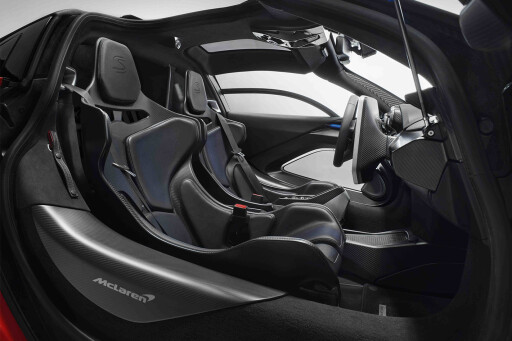
Owners can option to replace the lower door skin with a glass pane.
The Senna’s cooling requirements needed as close attention as the bodywork. “The rear clamshell, for example, was born from the twin demands of aerodynamic and cooling performance, with prominent ‘gurney’ flaps ahead of a succession of stepped louvres directing air away from the rear deck and down the sides of the body,” McLaren said.
“The resulting area of low pressure draws hot air out from the high-temperature radiators and engine bay, with the louvres ensuring that the airflow does not impact the efficiency of the rear wing. The ‘slash cut’ finishers of the unique Inconel and titanium exhaust exit through the lowest rear deck (measured at the trailing edge) of any McLaren road car, the angle of the pipes directing exhaust gas away from the rear wing.
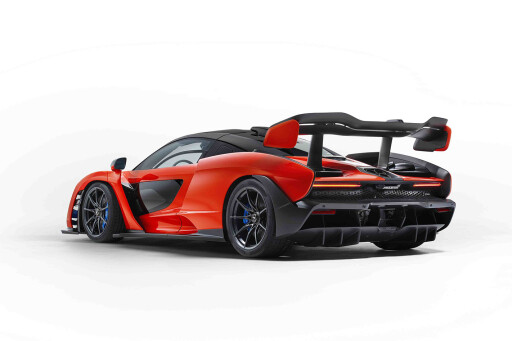
“The slim, rear LED taillights have been subject to the same exacting attention to detail as the headlights and every other aero-relevant component, the single-blade design minimising interruptions to airflow.”
The highlight, though, is that GT racecar-style double diffuser. “Created as a single piece of carbon fibre, it begins under the rear axle and as it increases in height accelerates air out from under the vehicle. This creates a low-pressure zone that sucks the McLaren Senna even tighter to the ground.
“Equally unmissable is a huge, double-element carbon fibre rear wing that at its highest point sits 1219mm from the road when the car is stationary. Hydraulically actuated and with a planform surface area of more than 6500cm2, the wing constantly adjusts to optimise the levels of downforce and aerodynamic balance and functions as an airbrake under heavy braking.”
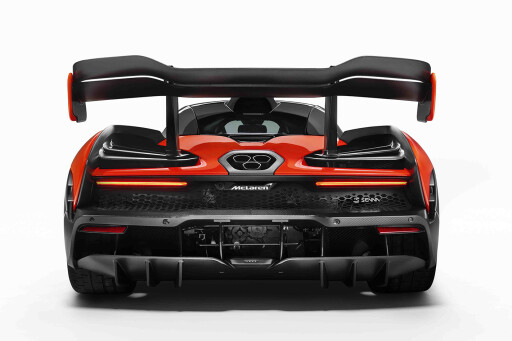
It will also be an aural experience, and not just because of the mid-mounted V8 sitting behind the seats. “From the outset of the program, McLaren engineers determined that the full mechanical symphony of the engine – from intake to combustion to exhaust – had to be central to the sensory experience.
“Those fortunate enough to drive the McLaren Senna will feel the cockpit come alive with the sound of air rushing into the roof-mounted ‘snorkel’ intake and mixing in the carbon fibre plenum, producing precisely tailored high-frequency sounds that deliver a vivid experience.
“At the same time, low-frequency sounds from the engine are transferred into the cockpit through unique engine mounts, exciting the double-walled rear structure of the carbon fibre Monocage and amplifying every change in engine revs, making it seem almost as if the V8 is sitting alongside the driver.”
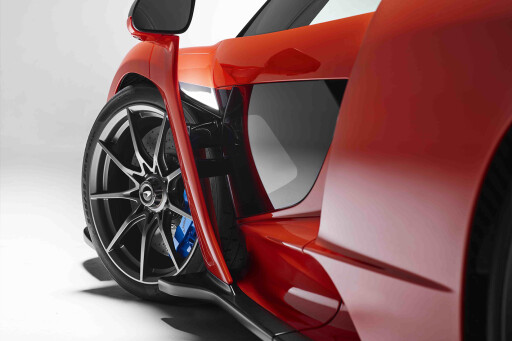
Power is sent to the rear wheels via a seven-speed dual-clutch gearbox. “A fully automatic mode is the default, with the driver able to choose full manual control of gear shifts via paddles mounted on a rocker behind the steering wheel. The elongated carbon fibre paddles are optimised to be used both with or without racing gloves, and create a deep sense of mechanical connection with the McLaren Senna.”
The McLaren Senna will make its debut at the 2018 Geneva Motor Show, which starts on March 6.

COMMENTS